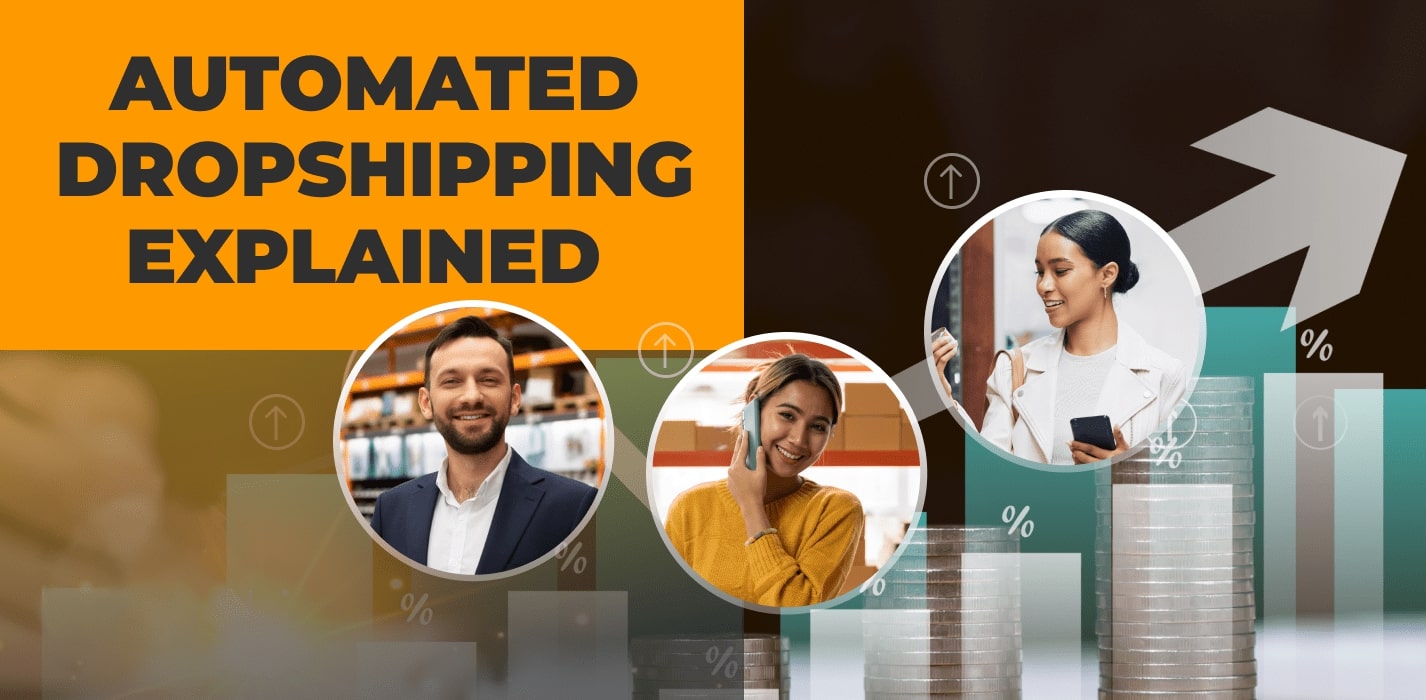If you’re here, you might already know that dropshipping is an order-fulfillment method and an ecommerce business model where online store owners don’t deal with the physical inventory, because the supplier is responsible for the logistics. Yes, it means that storage, shipping, delivery and returns are all done by the supplier. Now automated dropshipping is entering the arena.
We live in a crazy world where every second counts. So, as most ecommerce newbies ask, can dropshipping be automated? If yes, how? What’s the best automated dropshipping software and is it possible to spend only half an hour a day to successfully manage a multi-thousand-dollar store in 2024?
We’ll answer these and other questions in this Ultimate Guide on Completely Automated Dropshipping. Stay tuned!
Dropshipping vs automated dropshipping: where’s the difference?
Before all, we’re answering the first question: of course!
Not only dropshipping can, but has already been automated by millions of dropshippers from all over the world. The thing is that there are tons of separate solutions that automate this or that particular business process while you simply need to have one solution that automates everything. That’s the goal.
But before you get lost searching for that unicorn solution, let’s see first what processes and tasks you must automate to ensure the maximum efficiency of your business.
Automated dropshipping involves using tools and technologies to streamline the process, significantly reducing the time spent.
This business model is appealing due to its low upfront investment, enabling entrepreneurs to prioritize marketing and business growth. And since it appeared in the 70s (yes, before the Internet age), it’s transformed greatly, especially after 2010s when automated solutions interfered with the dropshipping industry to make entrepreneurial day-to-day tasks easier.
Of course, entrepreneurs created automated dropshipping to preserve and multiply the benefits of dropshipping which are:
Less money needed: You don’t have to buy products before selling them. So, you can start a business with little money. You only pay for the platform you choose: it can be a WordPress store, Shopify one, WooCommerce, Wix, etc. If you go with Sellvia, by the way, you don’t pay for the platform and get a store for free – the only thing you pay is your Sellvia PRO subscription which is only $39 per month, while other platforms will require thousands of dollars in payment, while also charging fees for necessary store operations (such as product import or order processing).
Logically, people search for woocommerce dropshipping automated fulfillment, amazon automated dropshipping or wordpress full automated dropshipping, but guess what? It’s basically all the same stuff, you’ll see why later in this Guide.
People also want free automated dropshipping, but of course, there’s no such an option when the platform is highly paid itself. It doesn’t make any sense if they say they won’t charge you for automated dropshipping when their dropshipping platform itself is paid, duh.
Easy to start: You don’t need a big store or a lot of space to keep products. You just need a computer and an internet connection.
Flexible: You can run your business from anywhere, as long as you have an internet connection.
Wide choice: You can offer many products in your shop because you don’t have to buy them first.
No risk: If a product doesn’t sell well, you can easily remove it from your store. You don’t lose money on unsold stock.
Focus: You can spend more time on selling and advertising because you don’t have to worry about packing and shipping products.
So, basically, you just attract customers to your store and make them happy – that’s the job.
However perfect it may sound for a dropshipping store owner, it’s not always easy, and there still are tons of little things to take care of! Otherwise dropshipping wouldn’t need automation, right?
Why will automated dropshipping be a must-have in 2024 and always?
Automation lets a dropshipper do tons of tasks a day without even feeling like it.
Promotion itself, for example, is a daunting task that requires learning, some marketing skills and dedication. However, no promotion = no clients.
And once you get a client, there comes store management and customer support, that’s why many new dropshipping entrepreneurs face strong pressure, can’t handle or even give up on their dreams of dropshipping success.
Imagine getting 100 clients in one day (which is totally possible, like, for example, with one of our current stores, The Auto Merch, which makes about $500k/month on average or Best Bargains, which makes $40K+), because you’ve recently got a promotion boost, but not being able to process them all, or processing them all manually with a million tiny mistakes!
This is what you get without automated dropshipping or any automated dropshipping software ( of course, you better go with fully automated dropshipping options to stay safe in this case).
As an outcome, clients don’t get their packages on time or don’t ever get them because you’ve made a mistake when filling in the address details, for example. And in the end you lose all those clients you got after investing money and effort in your promotion.
Sounds like a catastrophe? It is. What’s more, you can also lose your store’s reputation due to such occasions. That’s why it’s crucial to avoid them.
Having a dropshipping business doesn’t sound very inspiring now, huh? But worries aside: to beat all of those problems, entrepreneurs created automation. It’s been developed through the years of dropshippers’ pain and struggle to save the world! Now you can actually enjoy being an entrepreneur (finally), not just being satisfied with the profit your business generates.
You see? Using automation is just what you need to save your time, money, effort and business in general.
How does it work and how to use it for your business needs? To understand that, you, first of all, need to understand what it normally takes to do dropshipping manually. You can’t fully realize the necessity of automation until you learn what you need to do and how in this business, right? Let’s look at the things a dropshipper’s facing in their daily routine.
Automated dropshipping in a dropshipper’s daily routine
The daily routine of a dropshipper can vary based on the scale of their business, their experience, and the specific strategies they employ. However, here’s a general outline of what a typical day might look like for some ambitious person who’s operating a dropshipping business that brings stable profit, this is some kind of a maximum plan for maximum growth:
-
Morning Check-In
Emails: Review customer inquiries, supplier communications, and any platform notifications.
Orders: Check new orders that came in overnight. Ensure they’re being processed or have been sent to suppliers.
Financials: Review any payment issues, refunds, or disputes.
-
Product Management
Research: Spend some time looking for new trending products to add to the store.
Listing: Add or update product listings, ensuring all details (images, descriptions, prices) are accurate.
Inventory: Since dropshippers don’t hold inventory, this involves ensuring that products are still available from suppliers, updating availability status, or removing listings for items that are no longer available.
-
Marketing Activities
Ad Management: Review and adjust online advertising campaigns. This could involve platforms like Facebook, Google Ads, Instagram, etc.
Social Media: Engage with followers, post new content, or run promotions.
Content Creation: If they run a blog or produce other types of content, they might spend time creating or commissioning new pieces.
SEO: Review and optimize product listings, blog posts, and other website content for search engines.
-
Sales & Customer Service
Support: Address any customer inquiries, complaints, or issues. This is crucial for maintaining a good reputation and ensuring repeat business.
Feedback: Review customer feedback and reviews. Consider making any necessary changes based on this feedback.
Returns & Refunds: Process any returns, exchanges, or refunds. Communicate with suppliers as needed.
-
Learning & Strategy
Education: Dedicate some time to learn. Whether it’s about marketing, ecommerce trends, or platform-specific details, continuous learning is crucial.
Analysis: Review analytics and sales data to understand what’s working and what isn’t. Adjust strategies accordingly.
Networking: Engage with other dropshippers or ecommerce entrepreneurs, share experiences, and learn from each other.
-
Evening Wind-Down
Plan for Tomorrow: List down tasks and priorities for the next day.
Final Check: Do a quick check of emails, social media, and orders before ending the day.
-
Weekly or Periodic Tasks
Supplier Communications: Maintain good relationships with suppliers. This may involve periodic check-ins, negotiating rates, or discussing product quality.
Website Maintenance: Ensure the website is running smoothly, update plugins or themes, and make any necessary changes.
Strategy Review: Adjust mid to long-term strategies based on performance and changing trends.
So…question: Do you really think a modern human being can afford wasting SO MUCH time and effort on the repeated stuff? NO WAY!
As the business grows, many dropshippers start to outsource or automate certain tasks, such as customer service, marketing, or order processing, allowing them to focus on high-level strategy and expansion. But, you see, they should do it right from the start.
Trying to operate without automation is not just ineffective, but a competitive disadvantage, because most dropshippers have already started to switch to full automation. The ones who do it slowly simply get behind those who do it faster.
What is automated dropshipping today? What tasks can you automate? If we take the list above, we’ll be able to clearly see how drastically automation has changed the industry.
List of things that you can automate in dropshipping
Here it comes.
-
Order processing & fulfillment
Yes, morning check-ins dropshippers do daily have now shortened immensely! Of course, automated dropshipping can be different: there are fully automated, semi-automated and manual processing options still available now, provided by tons of different companies, but guess what? You only need the first one in this hectic life we live in 2024. With the full automation you just do a couple of clicks and voila – the supplier is already packing, shipping and arranging the delivery to your customer.
-
Product sourcing & importing
Tools and platforms can automatically pull product listings from suppliers and add them to your store.
-
Inventory management
Software can automatically update product availability based on supplier stock levels.
-
Price updating
Automation tools can adjust prices on your store based on changes from the supplier or predefined profit margins. Or just notify you if you want to stay up-to-day (which we’re sure you do). However, it’s always better to have a supplier that doesn’t change their prices, huh?
-
Price updating
Automation tools can adjust prices on your store based on changes from the supplier or predefined profit margins. Or just notify you if you want to stay up-to-day (which we’re sure you do). However, it’s always better to have a supplier that doesn’t change their prices, huh?
-
Customer notifications
Send automatic emails or SMS messages to customers about order confirmations, tracking updates, and other relevant information.
-
Refund & Returns Management
Automate the process of handling returns, generating return labels, and processing refunds.
-
Product reviews
In whatever business you have, trustability means success. Some tools can automatically import reviews from suppliers or other sources and display them on your product pages. At Sellvia, for example, every product you import to your catalog has a perfectly optimized product page with reviews and EVERYTHING to make your visitors buy the product from the first sight!
-
Marketing & ad campaigns
Use tools like Social Rabbit to automate your social media marketing and management, tools like Aweber to automate your email marketing campaigns and other apps created to simplify tasks for each promotion method you stick to.
-
Customer support
Chatbots and AI-driven support tools can handle basic customer queries and concerns.
-
Analytics and reporting
Automatic generation of sales, traffic, and conversion reports. No one likes to count everything in their head, let’s be honest. It is the age of machines, let’s use it and leave all the numbers to technology. With a Sellvia store you just get into the reporting section and always see the latest data collected from your whole business, how many sales you have, how much you’ve earned and when exactly, what your bestsellers are, etc. You just get everything you as a business owner need to know and enjoy the convenience automation bring you. No headaches.
-
Abandoned cart recovery
Send automated reminders to customers who left products in their cart without completing the purchase.
-
Upselling & cross-selling
Tools can suggest related products to customers based on their browsing or purchase history.
-
SEO Optimization
Some tools offer automatic SEO recommendations or tweaks to improve your store’s visibility on search engines. Chat GPT, for example, has recently got rights to access the Internet to get the most up-to-date information, that’s why now it can give you just the most fresh keywords, the best of the best content to boost your business.
-
Backup and security
Automatically back up your store data and ensure security measures are up-to-date. Sellvia, for example, does it for yourself.
Automated dropshipping in 2024, 2025 and further not only means a seller lets another company handle stock and order sending, using machines and computers, but also the whole complex of automated daily tasks dropshippers do like marketing in all kinds and ways.
Pros of automated dropshipping
Automated dropshipping is a modern twist on the traditional dropshipping model, leveraging the power of technology to streamline the selling process. By automating various operations, businesses aim to create a more efficient and error-free system. However, as with any business model, automated dropshipping presents both unique advantages and challenges.
One of the questions people ask most frequently in dropshipping now is “What is a fully automated dropshipping store?” In simple words, as you’ve already learned from the information we gave above, it’s when the stores automate their dropshipping setup technology to handle tasks that a human would normally do while running a dropshipping business.
However, I don’t think this is a good answer. When asked this question, I always just tell them to look at the pros it gives: you’ll understand what automated dropshipping really is when you see all of them!
Pros:
Enhanced efficiency: Automation speeds up the workflow, eliminating waiting times tied to manual tasks. You define the rules, and the tech executes them, making processes quicker.
Better accuracy: With fewer manual interventions, the chances of human error decrease. This results in higher-quality data, which aids in making informed business decisions.
Low initial investment: With dropshipping there’s no need to buy and store inventory upfront. Suppliers handle the product creation, storage, and shipping, enabling you to begin selling without heavy upfront costs.
Reduced operational costs: Automation minimizes losses from errors and speeds up many tasks. This efficiency not only cuts costs but also frees up resources for other business aspects.
When talking about cons, dropshipping newcomers normally tend to worry about the following ones:
Cons:
Sorry, but none. Unless you prefer to do everything with your own hands. Unless you see manual order processing and stuff as therapy.
Half an hour a day: how much it takes to run an automated dropshipping store
We know you love exact numbers (we do too). That’s why we’ve taken our stores that make average dropshipping monthly profit (like Best Bargains, our store that we mentioned before) and counted how much time exactly it takes to do daily tasks for them.

We weren’t pleasantly surprised, to be honest. Why? Because it’s been a while since we’ve integrated the latest technology into our stores, so, of course, it’s not a surprise for us now to spend minutes on everything, including order processing. Not even hours.
1 minute – log into the store’s admin panel, click the reporting section, choose the needed period of time. In our case, as we do the check-ups daily or twice a day, we choose the last 12 or 24 hours.
10 minutes – check and analyze the most up-to-date information on the store’s performance, revenue per product sold, total sales (profit), visitors, number of orders, average order value, conversion rate. If we see slight changes in numbers that’s okay, but if we see something too deviated from the average numbers, we elaborate ideas of measures needed to be taken in order to improve business performance and take action. Thanks to automated dropshipping options, you only need to do a couple of clicks to see all the numbers, no need to collect data manually or count anything yourself.
Pro tip: don’t rush into panic once you see low to no sales if your store is not yet old enough to make conclusions. You should at least have 1 month of data to see anything stable and take this information into consideration when analyzing your new statistics.
1 minute – moving to the Orders section in the dashboard to see if all the new orders have been processed. Thanks to the deposit function we don’t need to do anything to process orders in the Sellvia stores, it’s all done automatically.
Deposit is a free function at Sellvia (yes, other ecommerce platforms take a fee per each and every processed product. We don’t: you only pay the supplier (us) the original product production cost. Moreover, don’t forget that you don’t do it beforehand – you’re only charged when your customer has already paid you the final product price as shown in your store (which, of course is higher)! If we see unprocessed orders, we understand that we’ve run out of our deposit and it needs prolongation.
3 minutes – go to the Sellvia account and make a new deposit. We normally know how many orders we’re going to get according to the statistics, so we regularly make relatively the same deposit amounts. If you’ve just started and you don’t know how much money you’ll make the next day or week, start small.
But remember to check your store more often to see if there are no unprocessed orders. Who knows? There’s always a chance of making multiple sales per day so it’s very important to make sure you’ll be able to process them on time!
To make a new deposit you just go to your Sellvia account, click the “Deposits” section and choose the deposit amount you’d want to. Then click the “checkout” button and all done – your store is ready to automatically process all orders. You don’t even need to lift your finger to do anything and leave your customers satisfied, because while there’s a deposit – there’s immediate action we take when your store gets an order! All the products will be delivered on time to your clients, so you can be sure your store’s trustability factor grows non-stop.

7 minutes – go to the Products menu section to add new products to your catalog. Staying up-to-date with your product offering is one of the keys to ecommerce success. To add a new product you only make a couple of clicks and voila – the product is imported to your store with a beautiful product page: images, videos, detailed reviews, catchy descriptions – everything to make sure your store converts visitors into customers.
Repeat the procedure until you’re satisfied with the result automated dropshipping gives you – we normally add 10 to 50 new products, sometimes from other niches to test if the audience likes them and buys more. You don’t need to run into experiments if you prefer to go safe with your business strategy – better visit our blog section, YouTube channel research videos and Guides to see the proven products to add to your store after we’ve tested them out in multiple stores dozens of times.
5 minutes – talk to your customers. Seriously, talk to them. If you haven’t received emails from them, great, they’re satisfied with your product offering, special offers, and service. BUT it doesn’t mean you don’t need to talk to them! Your customers are your quickest and easiest way to grow profits. Always add interactive posts, polls, questions, stories, short videos, all kinds of live content on Social media to provoke replies and conversations in the comments or messaging sections. By doing so you find out more specific information on your customer’s needs and preferences to enable them to grow your assortment and multiply sales.
3 minutes (or more) – take a moment to review your marketing strategy and apply changes. Got active ad campaigns? Check if they work (we’ve got plenty of detailed content regarding all the promotion methods possible in our Marketing Academy).
Here it is, 30 average minutes in total.
Yeah, this is just the routine and does not apply to everyone – every business is unique and if you want to work 8 hours on your ecommerce business, feel free to do so! We’re sure it brings you the highest results (just don’t forget that you need to work smart, not hard).
All the rest of the dropshipping tasks are either done automatically or don’t require daily maintenance. Now, when you know how it should all be organized and how automated dropshipping makes your life as a business owner easier in 2023, let’s see what you need to do to achieve such a zen-mode of entrepreneurship!
Easy steps to set up your online store that does the work for you with Sellvia
Thinking of selling cool stuff online without the hassle? Automated dropshipping with Sellvia is the optimal choice. And once you go for a free trial, you’ll see for yourself at least a couple of reasons why:
You can use Sellvia for a comprehensive start
Sellvia isn’t just a platform; Beyond just hosting your store, Sellvia acts as your supplier, providing top-selling items made in the USA, from thousands of bestsellers to special high-profit items. It’s the gold standard for automated dropshipping.
You easily get the necessary knowledge
The journey with Sellvia isn’t just about selling; it’s about learning. They grant free access to their marketing academy, arming you with knowledge on the latest trends and techniques. With a plethora of precise guides, you’ll master the nuances of automation in marketing in no time.
You enjoy selling effortlessly
When a purchase happens, Sellvia takes over. They dispatch the product, ensuring a hassle-free experience for you. It’s streamlined, efficient, and epitomizes automated dropshipping.
The cherry on top? Quick deliveries lead to satisfied customers.
You’re always aware of your business performance
All the data you need is collected automatically in one place in your handy dashboard. No more brainers when it comes to finding out how many products you’ve sold and how much profit you’ve made, when and how you did it.
You stay updated on inventory
With Sellvia, inventory management becomes a breeze. The system lets you quickly see available stock, ensuring you never overcommit. Automated dropshipping means no unpleasant surprises.
Pricing made simple
Sellvia’s giving the ideal prices. You’ll strike the perfect balance, ensuring the highest profit margin with our proven bestsellers. Put up to $200 margin and be sure your product sells like hot cakes!
You engage and inform your customers
Transparency is key. With Sellvia, customers receive timely updates about their orders. Automated notifications mean both you and your buyer are always in the know.
And of course, you enjoy automated dropshipping at its fullest
No matter the task – you MUST automate and optimize it. The more the better, this is how 2023 works, this is how 2024 will work, and this is most likely how 2030 will too!
We’ve just seen and experienced the rise of artificial intelligence technology. We’ve learned it and we’ve learned with it, we’ve worked for it, so now it works for us, being implemented in every step of every dropshipping business process.
The time for revolution has come – don’t miss the opportunity to stay ahead of the competitors now, while automated dropshipping solutions like Sellvia give you the chance.
Tip: Keen on diving in without starting from scratch?
Sellvia offers pre-built online stores at no cost. Fully automated, these stores are ready for action. Whether adding products or checking sales stats, everything is just a few clicks away. See for yourself!





![It’s Never Too Late To Start An Online Business! [3 Examples]](https://sellvia.com/wp-content/uploads/2023/10/cover_Never-late-to-start-making-billions-min-1.jpg)

